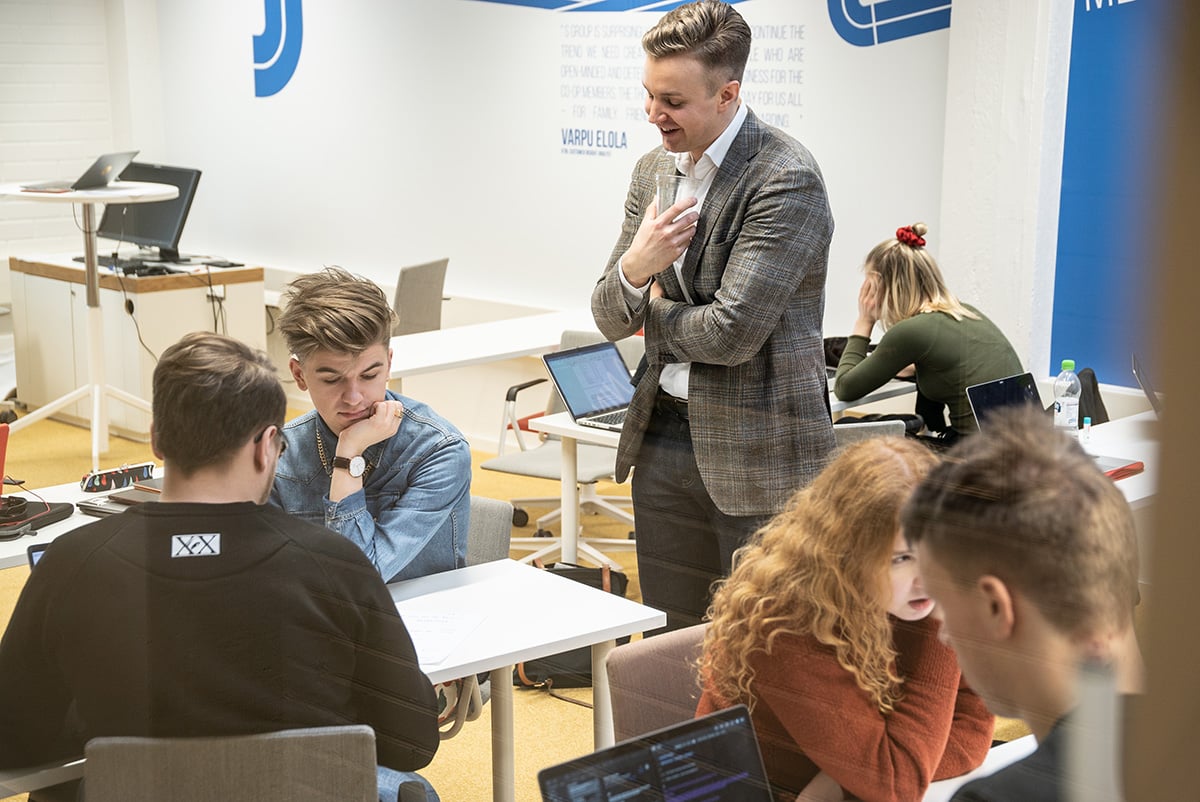The Data Handbook
How to use data to improve your customer journey and get better business outcomes in digital sales. Interviews, use cases, and deep-dives.
Get the book
The growth hacking course for university students in Aalto University – a collaboration between Columbia Road and Aalto University – was taught for the second time ever this spring. This was still a pilot course, but starting next year, the course is established as part of the official curriculum for a master’s program.
This year the theme of the course centred around NGOs and social good. Each of the four student teams was assigned an organisation, and their mission was to utilise growth hacking methodology to help the organisation reach one of its critical goals. All of the student teams reached measurable results and successfully contributed to a positive change in society in different ways.
Course client organisation projectsNaisten Linja – Organisation providing support for women in danger of abuse Väestöliitto – Family Federation of Finland, non-governmental organisation in the field of social welfare and health Kotitalousopettajienliitto – Home economics teachers’ association Sosiaalisen median ilmiöt – Aalto University’s open online course on societal effects of social media |
All together 9 Columbia Road consultants participated in the course by giving lectures, hosting hands-on workshops and mentoring the student teams. Based on feedback the course was a success, as it was last year, and we’re excited to continue contributing to the education of some of the brightest professionals of the near future.
But why is growth hacking so important that it's added to the official curriculum of Finland's top university? We collected the viewpoints of one of the guest lecturers, representative from a client organisation, the course professor and one of the students to have an overview of how this course was perceived by them.

Guest lecturer
Heikki Tiittanen
Director, Solution Sales at Reima (Founder & CEO of Finnish Baby Box)
Who are you and what is your history with growth hacking?
I’m probably best known as the Founder and CEO of Finnish Baby Box, a direct-to-consumer ecommerce startup. My history with growth hacking (though at the time we didn’t know we were growth hacking) started during my years as an intrapreneur at Sanoma Lab. We developed multiple new internal ventures for Sanoma, and with a couple of them we got far enough to start experimenting with growth hacking techniques. My personal growth hacking ‘thesis’ was the Finnish Baby Box and how we grew it without external investments from zero to over 100 000€ monthly revenue in two years.
Why is it important to teach growth hacking in universities?
Growth hacking skills are needed in every single company. It is very important that these skills are taught at the university level for future business leaders. Helping young talents is one of the most rewarding things in life so I didn’t hesitate for a moment when I was asked to give a lecture for this course.
What kind of an impact can growth hacking have on companies? Can you give a concrete example?
In my experience, growth hacking methods can have a great impact on companies. First of all, the methods are very effective and success is basically guaranteed if you just run enough experiments. I’ve also noticed that using these practices frees people from trying to invent and propose only the so-called ‘good ideas’. In growth hacking there are only validated and unvalidated ideas so every proposed idea is exactly as valuable. This helps people think more openly and propose more wild ideas that actually often lead to best results.
Maybe my favorite growth hack that everyone can try out is to actually call your customers and ask a simple question: “Why did you choose to buy from us?” I recommend everyone to try it out – you’ll learn very interesting things to work on for the couple of following weeks or months. Through these calls you’ll learn from the source why customers are buying from you and then you can start running experiments based on the results to grow faster.
 Client organisation
Client organisation
Ada Kairavuori
Communications planner at Naisten linja
What was it like to be a customer in this course?
Hosting this project was a good and educating experience for our whole team, and I think we all learned a lot from each other. Communicating and working with the student group was fun and effortless. And lastly, the results were better than expected – we got dozens of new membership applications during this collaboration. We are really glad that so many wanted to start supporting us through a membership.
Will you continue doing growth hacking in the future?
There’s no doubt about it. This project gave us plenty of ideas and hands-on tips for future member recruiting!
Was there something unexpected about growth hacking?
Well, at first ‘growth hacking’ sounded like it would be something rather complicated. As the project started and we got to see and learn what it’s all about, it was pleasant to discover that one doesn’t need to be a tech-guru to understand and to utilise growth hacking methods. It was surprising how even small-budget campaigns and quick experiments led to great and long-lasting results.
 Student perspective
Student perspective
Atte Makkonen
Student at Aalto University
Why did you take part in this course? Why is it relevant for your studies?
I had heard of the growth hacking phenomenon and that growth hacking is the future of marketing, but I didn’t have a deeper understanding of what it was. I wanted to broaden my perspective into the field of marketing, so I joined this course to understand how marketing is done nowadays. As I will soon be taking the next steps in my career, I want to be on the ball about what is relevant in marketing today.
Which learnings would you point out as the most important?
Understanding that growth hacking is another angle to marketing and that it’s not just marketing, it’s also research. I believe that growth hacking is a skill every ambitious marketing professional should integrate to their way of working, because the future of commerce is online. And we are already living in that ecommerce centric world.
How was the project you worked on?
I worked with my team for Naisten Linja, an organisation helping women to recover from violence. Our mission was to gather more members for Naisten Linja. It was educational to work the way we did – not just build social media campaigns, but to learn from them by optimising and building better campaigns afterwards. I acquired many growth hacking related skills that I believe I will benefit from in the future.
 Course professor
Course professor
Risto Sarvas
Professor at Aalto University
The growth hacking course at Aalto University was now held for the second time. Was there something new to it?
Just like last year, we had board lectures around different growth hacking themes, more specific sessions on tools and practices, and actual project work for external client organisations.
As the client cases were 100% real, it meant that the student groups had to face 100% real challenges. For example, not all clients had web technology setups that allowed the use of Google analytics tools. Another real world example was that due to the sensitive nature of personal data, students did not have direct access to some social media accounts. Lastly, sometimes the clients were not available and did not reply as quickly as expected, and in a course rhythm, this was not optimal.
Although these real world bumps caused delays and frustration, they also offered a concrete lesson on what growth hacking is in real life: technical challenges, client work, and adapting to each specific case. Nevertheless, the hands-on practical work with real clients was very much appreciated by students, as was the individual coaching and teaching we were able to have thanks to Columbia Road’s Toni and Samuli, and the rest of the team.
Why is the growth hacking course added to the curriculum?
As a course topic in our master’s programme, I believe this is extremely important. The course has now been run twice, and we have a good understanding of what works and what doesn’t. For example, fitting real clients and campaigns into a course schedule is not trivial and requires a lot of tweaking and creativity. However, the real campaigns and tools demonstrate to students that creating an impact iteratively and by measuring is very efficient. The principles behind growth hacking are simple and strong, and teaching them by making students experience the tools and campaigns is powerful.
Sometimes I wonder if young adults, such as our students, do not see the power of growth hacking because they are not familiar with the stiff and cumbersome ways of working out there in the real world. On one hand, that is just as it is supposed to be: why learn the old bad habits? On the other hand, it can be another lesson to be learnt: the world isn’t ready yet, and there is work to be done.

Keen on learning more on growth hacking? Learn how growth hacking can benefit your organisation and how you can incorporate it into your work and processes – Get your own copy of our popular Growth Hacker's Handbook below!
The Data Handbook
How to use data to improve your customer journey and get better business outcomes in digital sales. Interviews, use cases, and deep-dives.
Get the book





